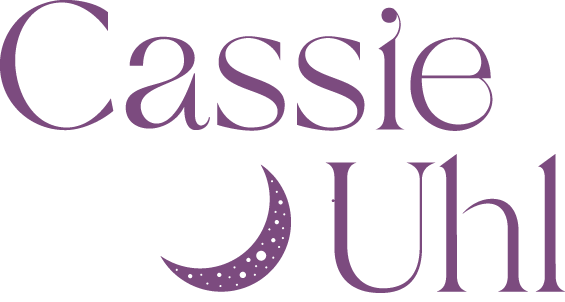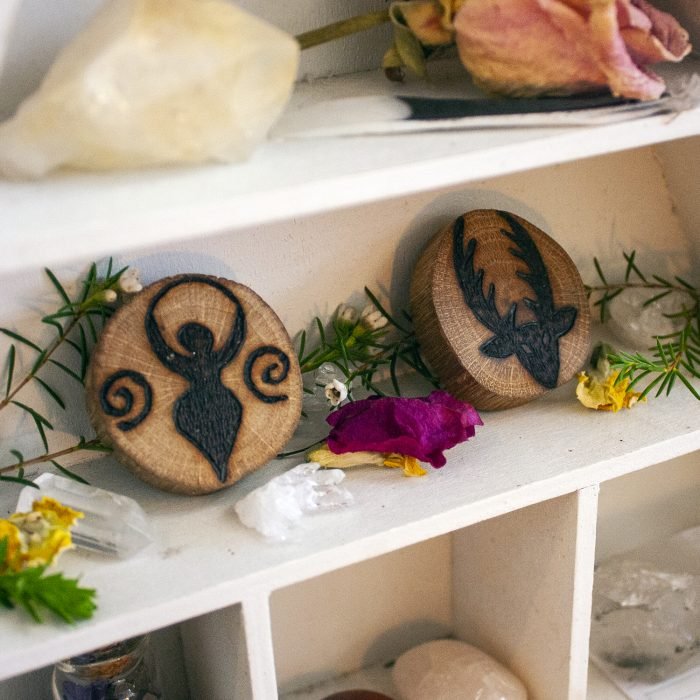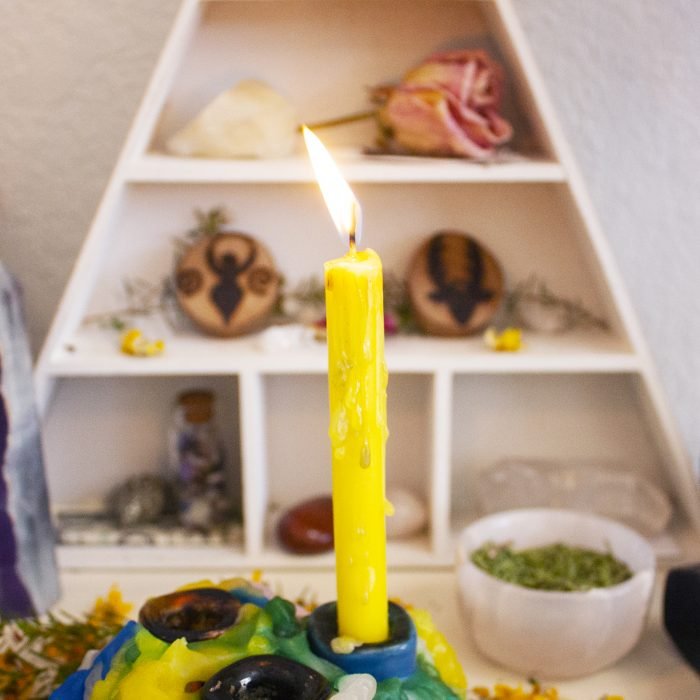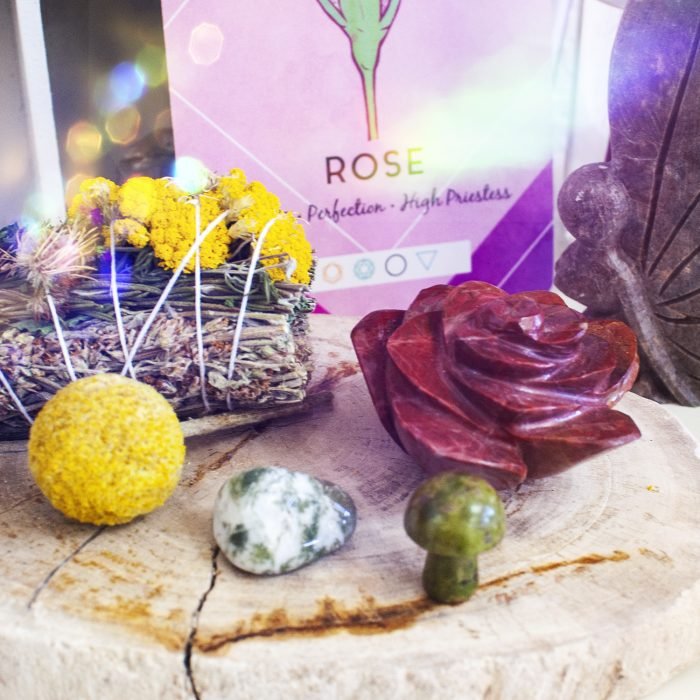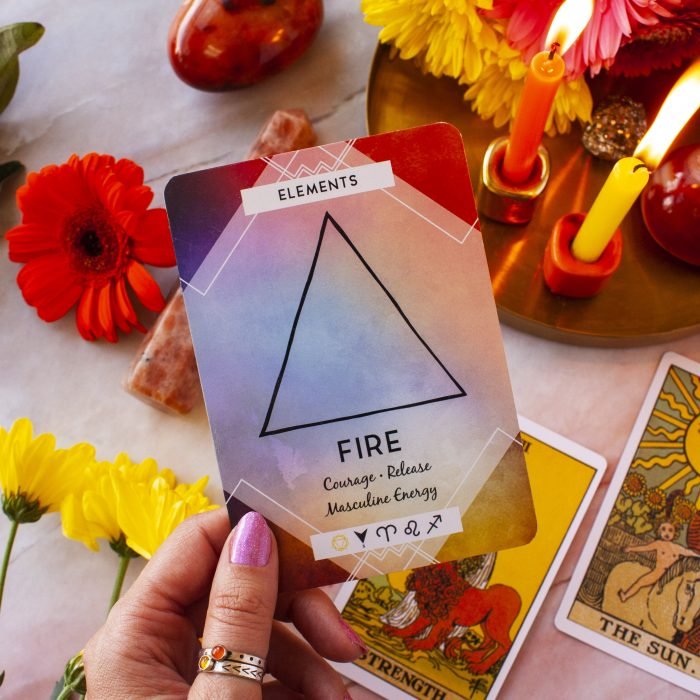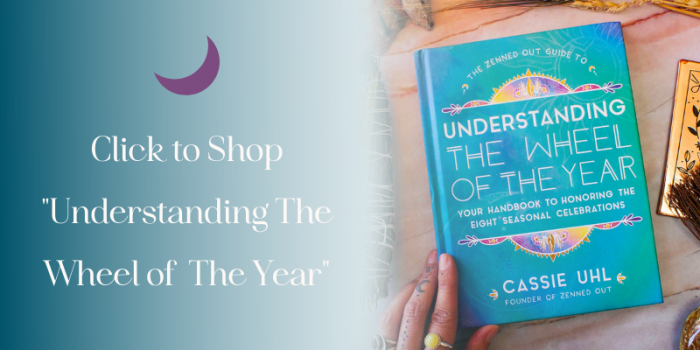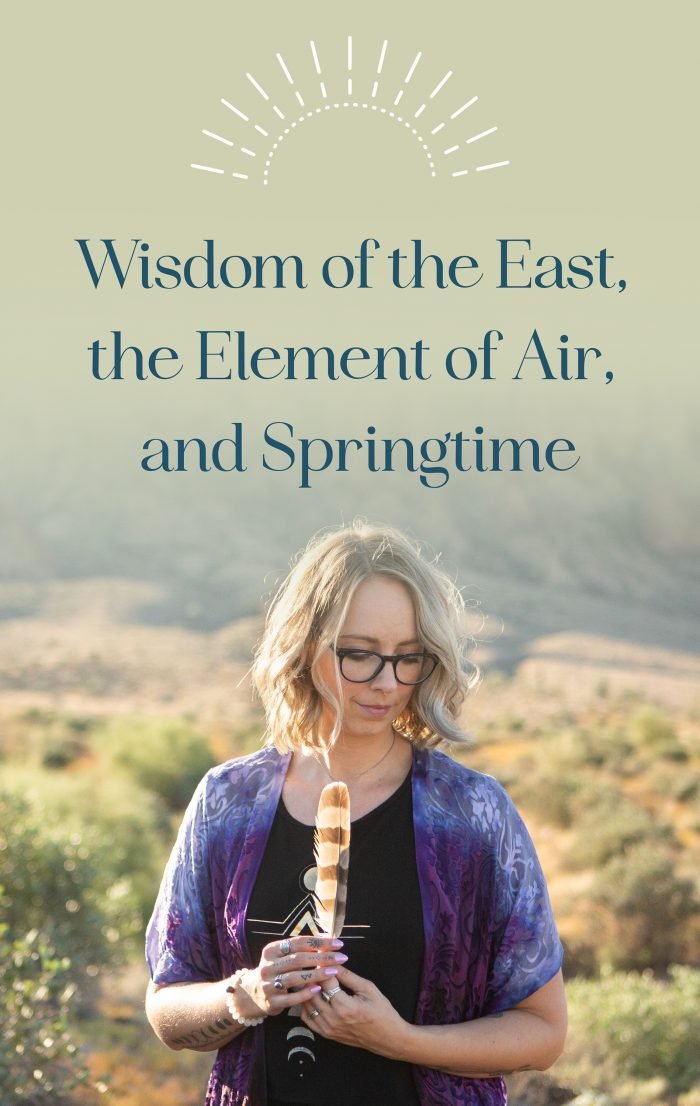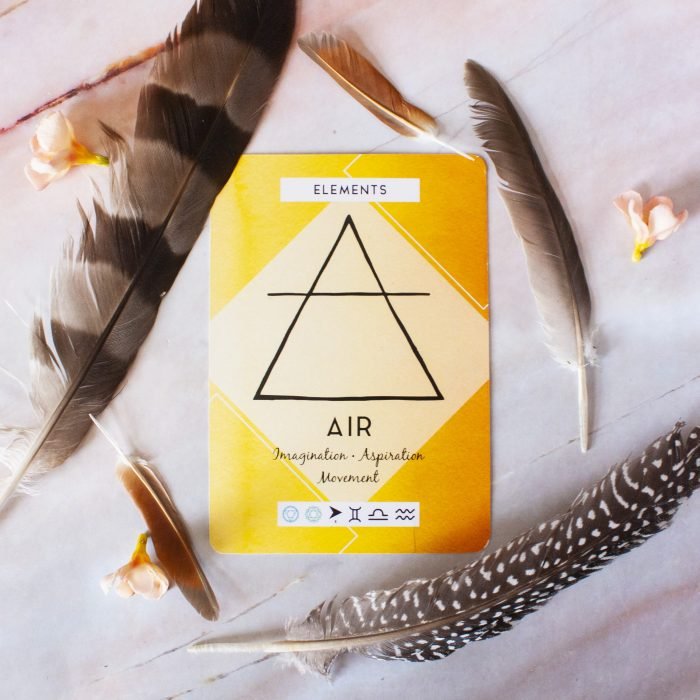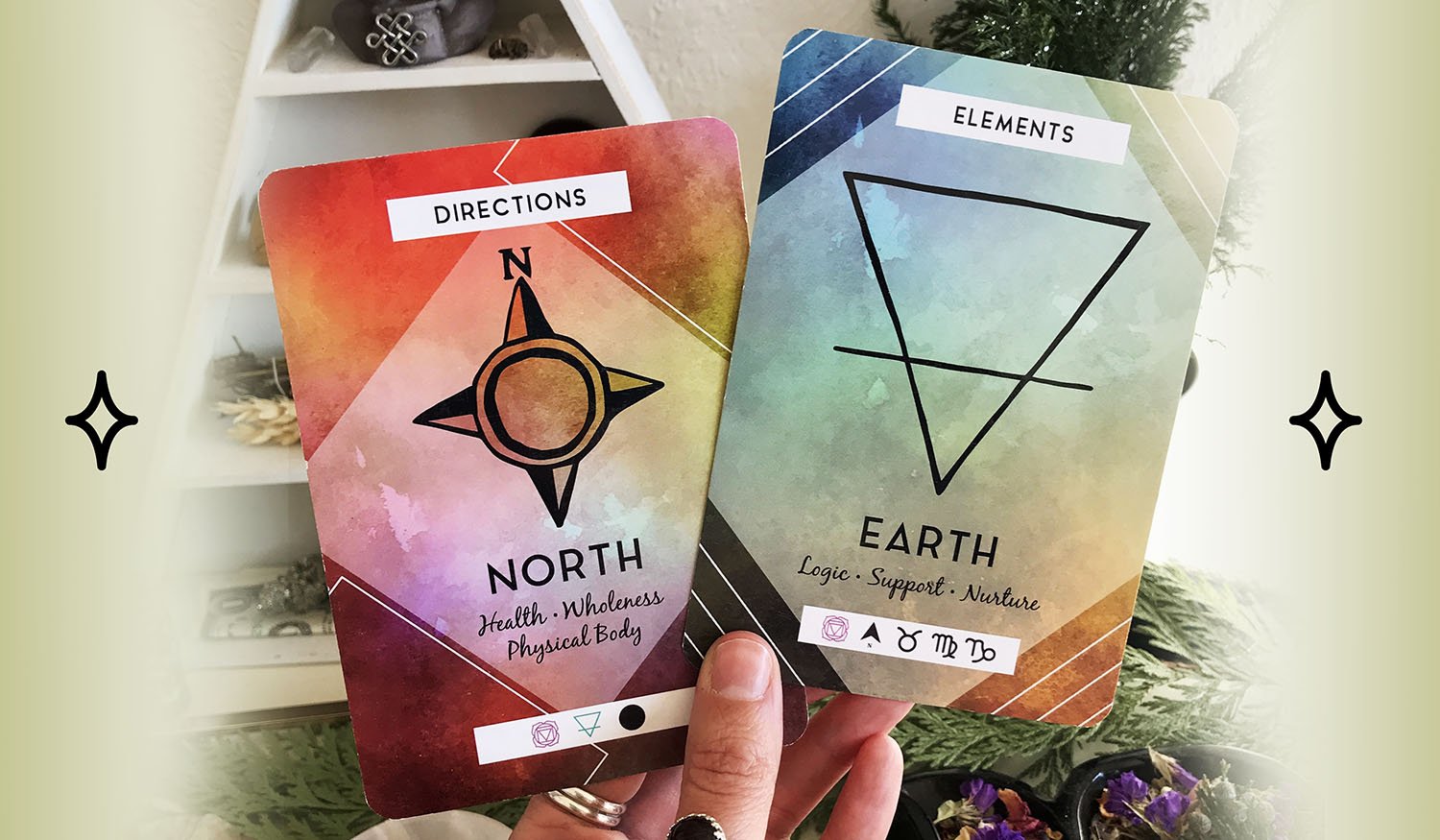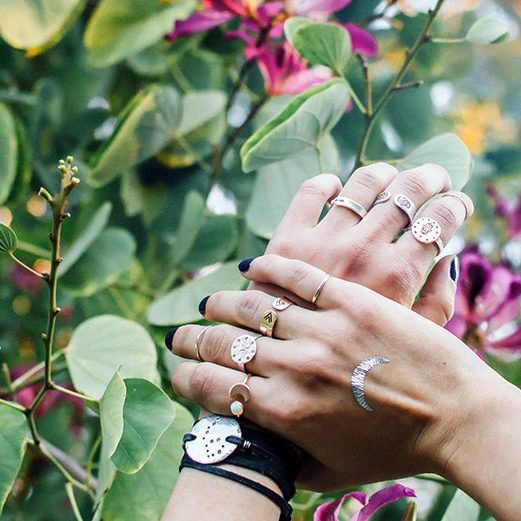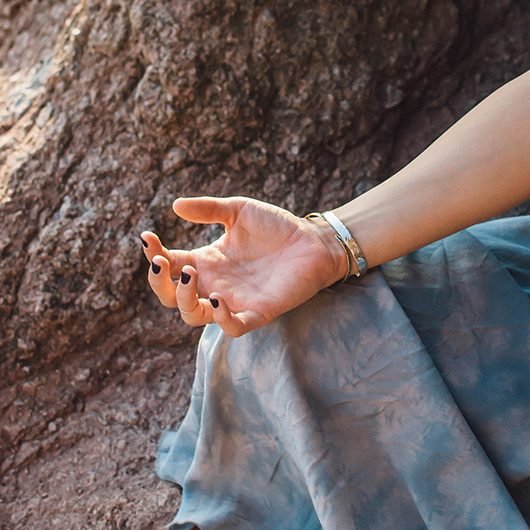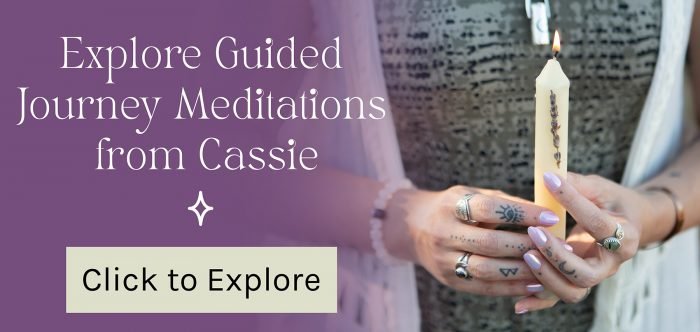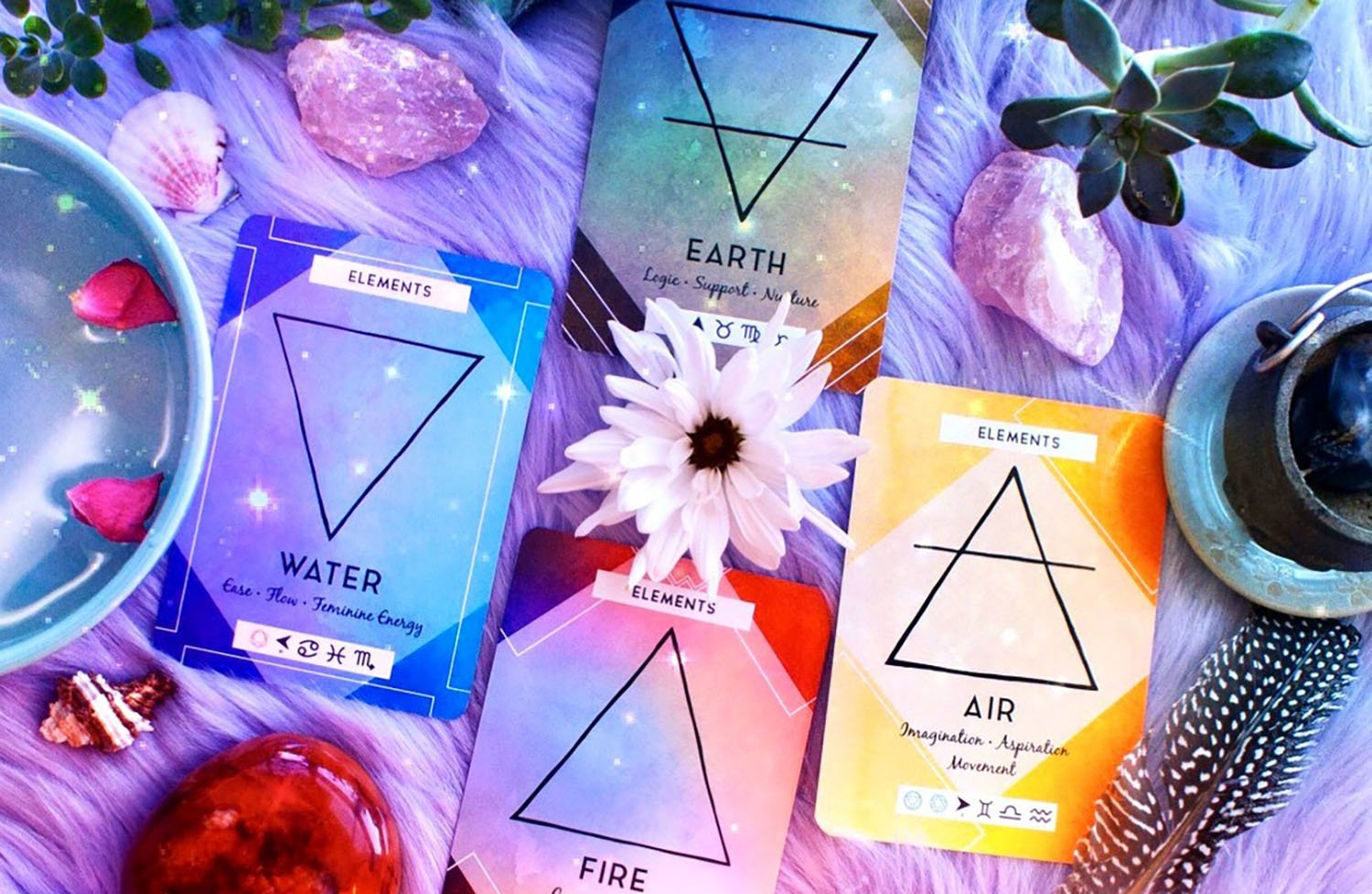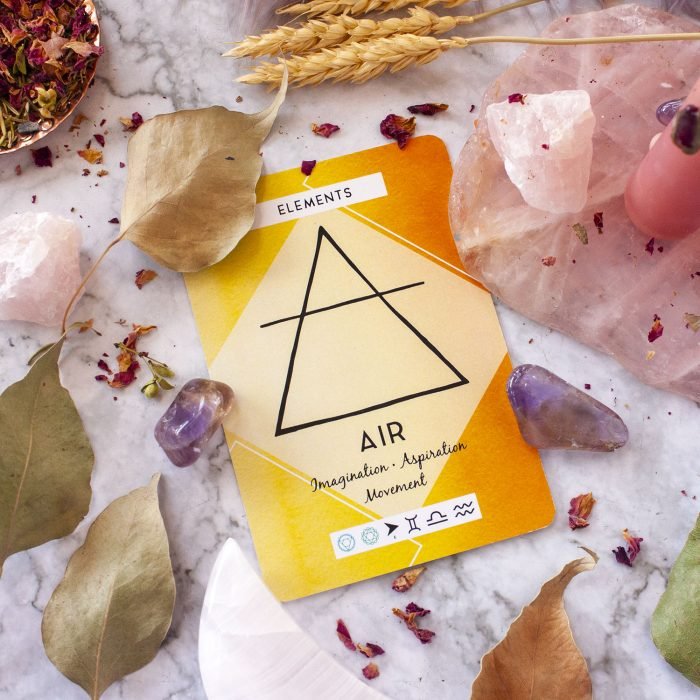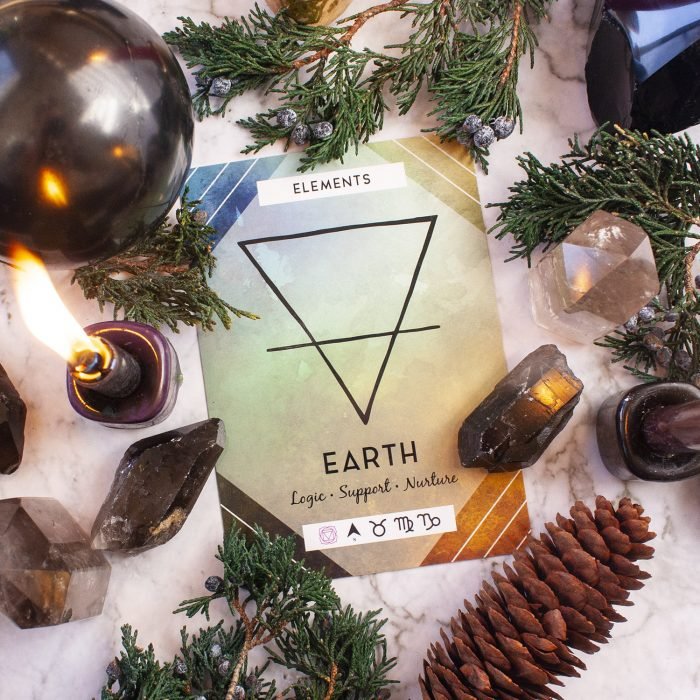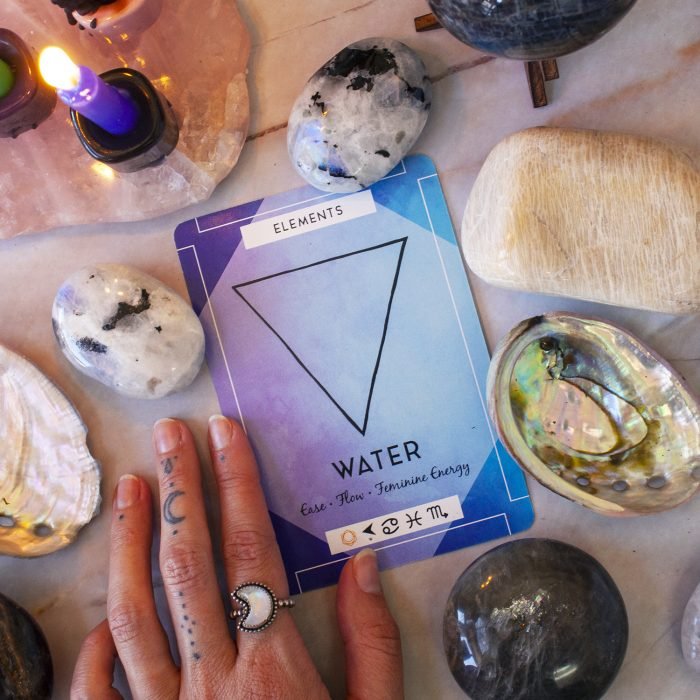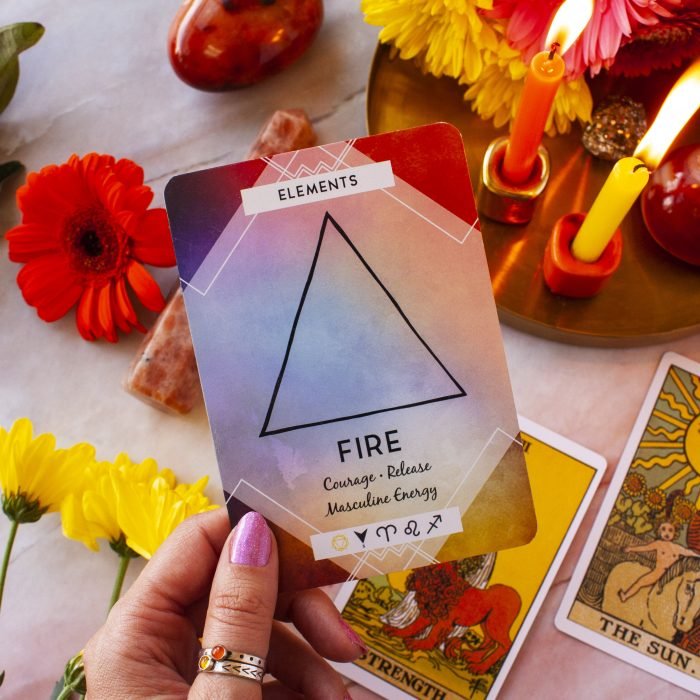New Moon in Gemini Ritual
The new moon in Gemini is an invitation to get curious about becoming more active in your community to spark needed change. Ruled by Mercury and a mutable air sign, Gemini is curious, communicative, and desires connection to work towards a more equitable future. Combined with the new moon, this energy encourages openness to new ways of connecting with your community to inspire change.
Tending to Your Inner Fire for Beltane
The warmth of fiery Beltane is nearly upon us, and this year (2022), with the addition of a new moon in Taurus with a solar eclipse! It's sure to be an intense and exciting Sabbat. Beltane has always been one of my favorite seasonal celebrations. I always find that its energy is palpable in the air. There's such celebratory energy to this season, which I feel like we could all use a bit more of right now. I know I certainly can!
The warmth of fiery Beltane is nearly upon us, and this year (2022), with the addition of a new moon in Taurus with a solar eclipse! It's sure to be an intense and exciting Sabbat. Beltane has always been one of my favorite seasonal celebrations. I always find that its energy is palpable in the air. There's such celebratory energy to this season, which I feel like we could all use a bit more of right now. I know I certainly can!
Beltane, also called May Day, is one of our cross-quarter celebrations between the solar celebrations of the Spring Equinox and Summer Solstice. For those living in the Northern Hemisphere, Beltane falls on April 30 and May 1 and on October 31 and November 1 in the Southern Hemisphere. In contrast, others may observe more traditional practices of honoring Beltane after the local Hawthorn trees flower.
Listen to this episode on my podcast, Rooting into Wholeness here.
You'll learn more about Beltane, its history, common correspondences, tips for connecting with Bel, a God associated with this season, and rituals to honor this season and tend to your inner fire.
What is Beltane
For many, Beltane is one of the most important celebrations on the Wheel of the Year. It is our crescendo of energy before the Summer Solstice. Beltane is opposite of Samhain on our seasonal wheel and therefore carries similar but unique energy. Much like Samhain, the veil between the physical and spirit worlds is thin at this time, making it an ideal time for magical workings, connecting with other realms, and energetic protection. In Celtic beliefs, Beltane welcomes the onset of Summer and the light half of the year, where the sun reigns supreme.
From an earthly perspective, Beltane ushers in a surge of growth and energy to plant life as the warmth and length of sunlight grow each day. For our ancestors, there was a special focus on pastoral animals like cattle at this time. Fire is a central theme for this season, and it was common practice to pass cattle through two large bonfires. The sacred smoke from these bonfires was thought to ensure a successful growing season for livestock. Fire and the ashes from these fires were used in various ways, both historically and to this day.
Amidst all this season has to offer, there's also a thread of pleasure, sensuality, and union that weaves throughout. Within the lore associated with Beltane, it is at this time that the Solar or Horned God, in his prime energy, unites with the Goddess of the land in her maiden phase. Together they reign over the growing season. Beyond the myths associated with this season, it's easy to see these themes of union and sexuality within the reproduction amidst wildlife and explosion of growth.
Honoring Fire and Bel
Much of this season is about honoring and cultivating energy and vitality, themes very much associated with fire. The sun and the earth are in their peak growth phase leading up to the Summer Solstice. Like all of the Sabbats, Beltane is an invitation to notice what's happening in the earth and the cosmos and to observe how those themes are showing up in our own lives and communities.
With little written history to go off of, the use of bonfires around this season is something we know has happened for a very long time. Here's an excerpt from Llewellyn's Sabbat Essentials Beltane by Melanie Marquis that illustrates this.
The Beltaine fires were believed to have magical properties. Their flames, glowing embers, ashes, and smoke were all believed capable of granting health and protection. In the Isle of Man, the people invited the smoke of the bonfires to blow over themselves and their cattle, believing that this would ensure their mutual vitality. Once the fires died down, the ashes were sprinkled over the crops to increase the earth's fertility.
Llewellyn's Sabbat Essentials Beltane by Melanie Marquis
The use of fire and smoke for ritual practice is something we can lean into today, and many do.
Most attribute the name Beltane to the Celtic God named Bel, Belinus, or Belenos and suggest that the name Beltane means "fires of Bel." Bel is a well-known God in the Celtic pantheon, honored throughout the British Isles and even in France and Italy. Stories and even the spelling of Bel's name vary widely, likely because he was so widespread. However, he's become synonymous with this season, and many associated him with fire and the sun.
Here's an excerpt from one of my favorite books about the Wheel of The Year, The Magical Year, by one of my teachers, Danu Forest, expressing the power of connecting with the power of fire or the God Bel during this season.
In honoring the festival of Beltane, we draw this fresh virile energy into our lives, a time when, according to Irish myth, the gods arrived in the mortal world, literally infusing physical matter with divinity. At Beltane, we can reinvigorate our lives with this divine current. We can also tune into this time of duality and sacred union to honor our hearts and the romantic and sexual energies in our lives.
The Magical Year by Danu Forest
I'll share rituals later in this post with suggestions for connecting with fire and Bel and ways to expand your vitality through pleasure, another common theme for this season.
I also want to share something I've struggled with because I suspect some of you may have struggled with this too. I don't often share about Gods here, which is something I've personally grappled with within my practice. As someone who grew up in a Christian household and has had negative experiences with Christianity and the idea of a "father God," I've struggled with connecting with different Gods in my practice.
I've started to dip my toe into this by invoking the God and Goddess as elemental energies (air and fire for the God and water and earth for the Goddess) rather than human-like forms. As I've become more comfortable with this, I've started to learn more about some of the Gods in the Celtic pantheon and have started to journey to them.
All this to say, if you don't resonate with Gods or Goddesses, it isn't a prerequisite to having a spiritual practice in line with your heritage. If connecting with the element of fire rather than the God Belinus at this time feels better, that is great. Regardless of where you land on connecting with Gods and Goddesses, I find that understanding some of the mythology associated with each season allows a more complete understanding of the Sabbats.
Let's explore common correspondences for the season of Beltane.
Beltane Correspondences
Understanding the correspondences of each season brings in so many additional layers. It also empowers you to craft your own rituals each season. As always, if there are seasonal things unique to your environment, add that to your list of correspondences for the season.
Themes: Pleasure, fertility, expansion, growth, sensuality, action, magick, creativity
Colors: Red, orange, yellow, green
Moon phase: waxing gibbous
Herbs & Plants: hawthorn, rose, honeysuckle, lilac, angelica, any local flowers blooming in your area
Crystals: Carnelian, garnet, ruby, orange calcite, protective crystals like black tourmaline
Foods: Fresh herbs, edible flowers, dairy products, cakes (especially as fairy offerings)
Tools & items: Candles, bonfire, statues or symbols of the God and Goddess, symbols of fertility, Maypole, protective tools and symbols, fairy offerings
Elements: Fire, earth
Cardinal direction: Southeast
Runes: Berkano, Algiz, Rhaido
Ogham: Oak (Duir), Hawthorn (Huathe)
Tarot card: The Lovers, Knight of Wands, Page of Pentacles
Zodiac: Taurus
Goddess: Bel or Belinus, Green Man, Danu, any earth Goddess, any Sun God
These correspondences largely come from my book, Understanding the Wheel of the Year. If you're looking for a simple guide for each Sabbat, you can get it here.
Rituals for Beltane
Beltane is a rich season with many associations, so there are several ways to honor this powerful season. As always, I like to remind you that rituals are not necessary for any of the Sabbats and that sometimes the best ritual is to simply be outside. I encourage you to honor your capacity and do what calls to you the most. Furthermore, each Sabbat is a season! You can weave these rituals into your practice anytime between May 1 and the Summer Solstice. Here are three ways to connect with and honor the season of Beltane.
Fae Offering
It's hard not to talk about faeries for Beltane! With the thinning veil at this time, the fae, or faeries, are said to be more active during Beltane. I'm not talking about the Tinkerbell-type fairies here! Faeries in Celtic lore are a different race of beings living amidst humans in a different realm. Though often portrayed as cute and helpful, some think they are better left alone. The fae are often seen as tricksters who don't always have our highest good in mind, so it's important to be mindful of them around this time and possibly even leave an offering for them. You can learn more about the fae and how to connect with them in this last post that I shared in 2021.
It's common to give offerings to the fae during this season to connect with them or keep them happy, so they don't play tricks on you. Your offering can be unique to you. Common offerings include small cakes, cheese, a glass of milk, herbs like thyme, rosemary, yarrow, or heather, anything small and cute, or perhaps you even feel compelled to craft a little faerie garden. Place your offering on your altar, outside at a special location, or both.
Fire Ritual
As discussed, fire is an integral part of Beltane. We see this mimicked with the connection to the Celtic God, Bel, and the use of bonfires during this season. Here are some ways to work with fire for Beltane, regardless of whether or not you have access to a bonfire. You can make this as simple or ritualized as you'd like depending on the time you have to dedicate to working with this ritual suggestion.
Fire element card from The Ritual Deck
You'll need:
A source of fire, which could be a bonfire, fireplace, or a burning candle
Herbs or wood that correspond to the season or is personally significant to you
Match, lighter, or more traditional tool to light your fire
1. Prepare your items and take some time to connect inward. Notice your breath and body. If it is in your practice to cast a circle, call the quarters, or call in any protective allies, you can do that now. You may even consider calling in the God Belinus to be a part of your ritual.
2. Light your fire or your candle. At the same time, you may choose to recite an invocation that feels meaningful to you. Here is an example, "I light this fire to honor and connect with the healing and protective fires of the season" or "With this fire I call upon Bel for wisdom and vitality." Beltane fires are traditionally lit with friction. If this is accessible to you and you know how to do this, that's great. I encourage you to do so! If it is not, that is okay too.
3. Spend 5-30 minutes sitting and connecting with your fire or candle flame.
4. When you're ready to move on, add your sacred wood or herbs to the fire. If you are using a candle, you can use a cauldron to assist with burning your herbs or wood. Ask the smoke to cleanse you and bring healing.
5. Spend some more time connecting with your fire. Here are a couple of options.
If you have questions you'd like assistance with, consider asking the fire. Notice how the fire or flame responds after you ask it questions. Does it seem to flicker and dance or remain still? Does it move towards you or away from you? Try to lean into your intuition to decipher messages from the fire.
Alternatively or in addition, you can connect with the fire to cultivate more energy and virility. Visualize the intensity of the fire connecting with your solar plexus area. Ask the fire to aid you in bringing in more energy and virility. Imagine your solar plexus area expanding with each breath you take. Stay here for as long as you'd like.
6. When you feel ready to end this ritual, thank the spirit of fire and any allies you called in for connecting with you and sharing their wisdom and energy. As much as is possible, allow your fire or candle to burn out on its own. If this is not possible, you can snuff it out. Never leave your fire or a candle unattended!
7. Optional: if you burned a larger fire, consider saving these special ashes to sprinkle over your garden, in your houseplants, or for use in future rituals.
Honoring Pleasure
There's no shortage of pleasure and sensuality amidst this season. Beltane occurs during Taurus season, which offers a potent overlap of energies. Taurus, ruled by the planet of love, Venus, revels in physical luxuries and sensuality. We can see these same themes mirrored in the growing earth at this time, with flowers blooming, animals reproducing, and plants growing. Handfasting and weddings were and still are common occurrences during this season as well. Regardless of what your love life looks like, pleasure is something that can be cultivated with others or solo, and this is a great time to do so!
Rose oracle card from The Ritual Deck
In a world that often frowns upon sexual liberation, I view this season as one of reclamation for all things related to pleasure and sexuality. However, this isn't just about lust and sex, though it can be. Pleasure and sexuality are powerful creative energies that can be used for positive change. Cultivating pleasure can be just as much about feeling more embodied and alive.
How often do you let yourself feel good? Furthermore, how often do you cultivate feelings of pleasure? This season is an invitation to do just that. If feelings of shame or that you're undeserving come up, I encourage you to explore that too. Like every seasonal Sabbat, they are an opportunity to explore these themes from all angles and may stir up opportunities to explore your shadow more deeply. Here are some simple ways to honor pleasure this season. Feel free to pick and choose, try several simultaneously (my preference!), or come up with your own ideas.
Wear clothes that make you feel good
Pamper yourself with a luxurious bath
Indulge in foods that bring you joy
Place items in your house that invoke a sense of pleasure, like flowers or candles
Swap massages with a partner or give yourself a self-massage
Engage in sexual activities with a partner or yourself
Wear or use scents in your living space that invoke feelings of pleasure
Move your body in sensual ways through dance
Bring in some magic to any suggestions listed above by lighting an orange or red spell candle or incorporating seductive scents like rose or cinnamon. Notice how you feel after engaging in pleasurable activities like those listed above. Does it give you more energy? Does it inspire more creativity?
I hope you feel better able to honor this special time of year! Find card spread suggestions, rituals, journal prompts, and more for each Sabbat in my book Understanding the Wheel of the Year. You can also read past posts about Beltane by clicking here. Beltane blessings!
Opening to the Wisdom of East, Air, and Springtime
The Spring Equinox shifts our seasonal wheel to the East, the home of the element of air, inspiration, and new beginnings. In this share, you'll learn all of the delicious correspondences for this season, the significance of the season, how to deepen your connection with this season, and why you'll want to. This is a continuation of a larger series of exploring the wheel by seasons.
The Spring Equinox shifts our seasonal wheel to the East, the home of the element of air, inspiration, and new beginnings.
In this share, you'll learn all of the delicious correspondences for this season, the significance of the season, how to deepen your connection with this season, and why you'll want to. This is a continuation of a larger series of exploring the wheel by seasons.
If any of it sounds foreign or new, I encourage you to go back to read or listen to the episode about the North here, where I dive a little deeper into sacred wheels and their uses across cultures.
Listen to this episode on my podcast here.
Every seasonal shift is an invitation to see the natural world as a mirror to our own lives and a call to notice how you are reflected in the natural world because you are the natural world. No matter how separate you may sometimes feel, you are nature. You are earth. Each shift is a call to remember this truth and attune yourself to these natural rhythms.
Do you ever feel like you want a roadmap for life? Living cyclically offers a map. A map that reminds you to allow for times of expansion and growth as well as times of rest and even death and destruction. The roadmap of living cyclically with the seasons may not always be fun and exciting, but that's because life isn't always fun and exciting. Life is fucking hard sometimes, and living cyclically normalizes that truth.
The season of Springtime, governed by the cardinal direction East, begins at the Spring Equinox and spans Beltaine until we reach Midsummer or the Summer Solstice. There are so many juicy things unfolding in this season. It's a season of action, play, and expansion! Let's explore the wisdom of the East and what this season has to offer.
Wisdom of the East
On the sacred wheel, we shift East as we shift to the Spring Equinox. This shift also brings the beginning of a new zodiac year with Aries season. An immense burst of energy happens as we move into this season, and it's often easy to see in the natural world. It's getting warmer, the days are getting longer, and plants are starting to wake up. The earth is fertile for new life, and so are you.
As a collective, oh, how we need some East energy! As I prepared this episode, something that stood out to me was the word humility. Being in a space of humility is very much associated with the East. There is action here, but there is also an openness and willingness to be open and allow new wisdom to permeate your being. It's a space that encourages us to be okay with not knowing. Humility seems to be something we've been missing deeply in our divided society. There's so much time and energy claiming to be the correct person with the only correct answer. I don't say this to point fingers; I certainly get caught up in it at times as well. This season reminds each of us that no one knows everything and to be open to new ideas.
You know what I love more than anything is when someone says, "I don't know." What a breath of fresh air. This is the home of the East, the humility to continue to be open to continue to learn. We are each given this opportunity during this season to honor the not-knowingness, to sit in it, and to be open to what gifts of wisdom may want to come through.
Air Element Card from The Ritual Deck
Just as the plants begin to form buds and burst forth with life, your inner world is fertile for new growth. On a personal level, this season encourages you to open yourself up to new paths and to begin taking action. Feelings of uncertainty are a natural part of taking steps towards building something new; the East reminds us of this, that part of beginning a new path requires a certain amount of trust.
You don't wake up knowing everything that will transpire throughout your day; there are always certain unknown or out-of-control elements. The East invites you to honor this and embark on your day regardless. The tree doesn't know that it won't be struck down by lightning or some other unforeseen force as new buds and leaves grow, but it grows anyway. The tree does not sit wondering how I will grow these leaves, even amidst all the pain in the world. Rather it tends to its needs, supports life around itself, and continues to grow. We can apply this same thinking to new endeavors. Even when the path ahead is scary and unknown, you can move forward with what you do have and trust that you will know how to address situations as they arise.
Here's a snippet from a book by one of my mentor's mentors called "Sacred Wheel of Our Ancestors" by Roberta Lee. I don't think it's in print anymore, and it's more like a pamphlet than a book, but you may be able to do some digging to find a used copy. In the chapter about the East, she says.
"It is in the East that we can call out and beg to know our paths. For this is the first step of many on this journey. However, be aware that while you search for your path, you're probably on it. If you cannot see it, it is likely that it is because you walk it. If you do see it, perhaps you are not there as yet. So take that step.
This is the place of surrender, of abandonment to the Great Mystery, of life itself. It is a commitment; certainly, a sense of risk accompanies us as we face the East. Dare to look into that sunrise, sense the warmth and healing of the sun as it begins its daily journey across our sky."
Sacred Wheel of Our Ancestors by Roberta Lee
East Correspondences
There are so many beautiful ways to connect with the energy of the east. Springtime itself is something that so many look forward to, so it's the ideal season to simply enjoy nature. If it doesn't yet feel like spring where you are, or you'd like to get in touch with the energy of the East in a different season, here are some ways to honor this season through corresponding energies or energies that match each other.
Moon Phase: Waxing crescent
Phase of life: Childhood / the Maiden
Themes: Play, joy, curiosity, fertility, growth, expansion
Color: Yellow
Element: Air
Time of Year: Springtime
Time of day: Dawn
Items and tools: Flowers, eggs, herbal smoke, feathers, fresh herbs, rabbits, and hares
Crystals: Kyanite, citrine, quartz
Tarot: Suit of swords
Ogham: Nuin/Ash and Huathe/Hawthorne
Air and East oracle cards from The Ritual Deck
Rituals to Connect with East
1. Honoring your inner child with play
Opening ourselves up to new ideas and wisdom can be hard. As we grow older, we tend to get more and more set in our ways for most of us. On a physiological level, our brains are less able to learn new things. It takes more of a conscious effort to open yourself up to learn new things. One of the secrets to being able to do this is allowing yourself to be open and receptive, and play is a powerful way to get into this receptive state of being.
We already know that young children learn through play. Why is that? Play forces us to be in the moment, which opens us to new ideas and ways of being. It allows us to temporarily let go of all of the things we feel we need to carry as an adult—the money, job, responsibilities, and so on. Play is an opportunity to distance ourselves from all of these storylines and be present in a different way. Play is unpredictable and therefore fosters experiences of new insights. It cracks us open in a way.
I'm fortunate to have two 3-year-olds in my life, so I'm frequently given opportunities to engage in play. Even with my two little busybodies, I still have to remind myself to let go of all the weights and stories I'm carrying and just be with them. Like everything, play can take some practice too.
The way you decide to engage with play, children or not, will be unique to you. I encourage you to take some quiet moments to reflect inward and ask yourself what would feel like a playful and freeing activity to engage in. It may be on your own, with your kids, or with a partner. Consider thinking about what your favorite playful activities were when you were young. There's no wrong way to do this and no desired outcomes. Your only goal is to allow yourself to be in the energy of play, whatever that looks like for you.
Here are some soft suggestions if you feel stuck.
Draw, paint, or color with no desired outcome
Cook or bake a new dish that excites you
Turn on some fun music and move your body
Make something with recycled materials
Learn a new song and sing it to a friend or some plants
Play a game solo, with family or friends
Explore a new area of your city
Draw, paint, or color with no desired outcome
Cook or bake a new dish that excites you
Turn on some fun music and move your body
Make something with recycled materials
Learn a new song and sing it to a friend or some plants
Play a game solo, with family or friends
Explore a new area of your city
Another way to honor your inner child is to bring healing to your inner child. So many of us carry wounds related to trauma that happened to us as young children. There are several ways to approach inner child healing, one way is therapy, but there’s also a lot you can do on your own. Personally, I found a lot of healing through EMDR therapy, but I’ve also approached my inner child healing from a spiritual perspective as well by journeying to parts of my childhood that needed healing.
If this is an approach you’d like to try I held a group guided journey for this that’s now available in the shop. Of course, you can do this on your own as well, but if you’d like some support there’s a workbook and recording to help guide you through it. Click here to explore it.
2. Connecting with the maiden of the Triple Goddess
We have the maiden, mother, and crone in our triplicity of Goddess archetypes. Each phase carries its own unique energies with both negative and positive attributes. The maiden aligns with the waxing crescent moon, steeped in exploratory and expansive energy. The maiden honors seek to expand, learn and grow in new ways. They do not shirk away from pleasure and rather lean into it.
You do not need to be a particular age to lean into this energy; it can be called upon at any time in your life regardless of age and gender. This season is an opportunity to notice your relationship with the maiden and lean into it. How do you feel when in the presence of someone who feels safe and empowered in their sexuality and pleasure? Does it make you feel uncomfortable, angry, or do you celebrate them? The way you respond or feel when presented with the energy of the maiden can be a big indication of what your relationship is like with yourself in this area.
Aphrodite card from The Goddess Oracle
There are many ways you can connect with the maiden energy. One way is to connect with maiden Goddesses. Every culture has maiden Goddesses, and I encourage you to explore Goddesses in line with your heritage. Here are some of my favorites that I often work with at this time.
Eostre is a Germanic and Norse Goddess of the Springtime. The first written history of Eostre did not come about until a Christian monk named Bede wrote about her in 725 AD. This doesn't mean she wasn't around before this, but we don't have any evidence that she was. Eostre embodies the energy of fertility and growth. She's strongly associated with eggs and hares, both symbols of fertility.
Freya and Frigg, a Norse Goddess (who some separate as two separate Goddesses) associated with pleasure, sexuality, and magic. Freya simply means lady, while Frigg comes from a root word for "beloved." We can even see Freya's connection with love and pleasure even today on our weekdays. Friday, the day of the week corresponding with love and romance, comes from the "day of Frigg."
Aphrodite and Ishtar are also associated with love and pleasure, which can be powerful to connect with or learn about at this time. Aphrodite is a Greek Goddess who many believe was modeled from the Middle Eastern Goddess of love, sexuality, and battle.
There are so many ways to connect with and honor different Goddesses at this time. Consider meditating or journeying to connect with them. You could set up an altar to honor and celebrate them or learn about them. If you're feeling overwhelmed with which Goddess to connect with, I encourage you to go within and open yourself up to connecting with a maiden Goddess to see who and what comes through. We all have connections to different deities through our heritage, and sometimes the best way to connect is by honoring your inherent wisdom.
If connecting with deities isn't in your practice, consider meditating during the waxing moon phase, exploring your sexuality, or working with magical tools that invoke a sense of pleasure and fertility to connect with the energy of the maiden.
3. Connecting with the element of air
The element associated with this season is air, so honoring and connecting with this element is a potent way to feel into this season. Air is such a unique element. Unlike the other elements, we can't see air. We can see its effects as it swirls about, but we cannot see air itself. This truth brings a unique energy to this element and how we connect with it.
The air element is an active and outward-facing force that sets things in motion. It is also clearing but not the same healing way that water is. Rather, it brushes aside things so that we may be permeated more deeply. Air aims to mix and swirl about our perceived realities so we can see things from a new perspective.
I think it's important to note that as we shift into Springtime and East on the wheel, we simultaneously move into the fire sign of Aries. We all know what happens with fire gets some extra air; it grows, it gets bigger. I see it as another beautiful expression of the power of this season.
When out of balance, air can push us towards overthinking, anxiety, and lack of focus. Air can be overwhelming. We can see this quite easily in the suit of swords in the tarot, which corresponds with the element of air. In many ways, the suit of swords is one of the more feared suits. There's so much pain and mental anguish present on the cards.
It's as powerful as a sword when you learn to engage with air in a more controlled way. Wielding the force of air allows you to cut through perceived realities and see new pathways. Air is the gracious idea bringer, and your job is to discern what's for you and what isn't. Air gives you the voice to say what needs to be said with truth and compassion. Air, though invisible, has the power to knock over buildings or subtle enough to blow out a candle.
A powerful exercise to cozy up with the element of air and the tarot is to spend some time with the queen and king of swords. Notice how they appear so sovereign in their ability to control their chosen tool. This tool goes for any of the elements. The Kings and Queens of the suits show us what each element looks and feels like in its most exalted form.
Beyond the tarot, I love experiencing the element of the air outside. Notice how the air feels against your skin, what it stirs within you, and how it makes you feel. I start so many days looking outside and noticing how the trees are moving from the air. I use it as a form of divination, a little nudge to be more still or to get busy. I've received so many messages from my "tree friends" by way of how the air moves them. I love visualizing the air clearing away blocks and stuck energy so that I may see and know more clearly.
With spring upon us, I hope you can find time to be outside amidst the air, to feel it blow through your hair and over your body. I hope you can allow it to push aside any stories you need a break from so you can see things from new and playful perspectives. I hope you can honor your inner child and the maiden within you, calling out for play and pleasure.
Honoring Imbolc and Brigid
Imbolc is our collective season of hope and renewal. I liken it to the star card after the tower. We've been deep in the cauldron throughout Samhain and Yule, and with the arrival of Imbolc, we can start to see the slightest stirrings of life and an increase in sunlight. Imbolc brings a palpable sense of renewed energy in the air.
Imbolc is our collective season of hope and renewal. I liken it to the star card after the tower. We've been deep in the cauldron throughout Samhain and Yule, and with the arrival of Imbolc, we can start to see the slightest stirrings of life and an increase in sunlight. Imbolc brings a palpable sense of renewed energy in the air.
In this share, you'll learn more about Imbolc, common correspondences, and ways to connect with the Goddess Brigid through rituals for the season.
What is Imbolc?
On the wheel of the year, Imbolc is the midway point between the Winter Solstice and the Spring Equinox. It occurs on February 1st and 2nd in the Northern Hemisphere and August 1st and 2nd in the Southern Hemisphere. Imbolc translates to "in the belly," which refers to a couple of things for this season. This season is often called "the quickening," which relates to the time in utero when the mother first begins to feel movement from her baby. The earth is starting to show signs of first stirrings as well. The second reference is that ewes often gave birth during this season, which was of utmost importance to our ancestors as it provided nutrient-rich milk to those in the community.
Imbolc is a time to tend to your hearth, home, and physical well-being on a personal and energetic level. It's also a time to tune into feelings of hope and renewal. Imbolc energy aligns with the early stages of a freshly waxing moon. It's a time to explore what's inspiring you and cultivate more of that inspiration. If you have specific goals or intentions in mind for the year ahead, this season is the time to form a solid plan and begin taking action. Like all seasonal celebrations, there's also a theme of community that weaves through Imbolc, which I find is often overlooked but important.
Listen to this post on my podcast, AwenGuided by Spirit, here.
The Goddess Brigid, who we'll discuss in more detail, is strongly tied to this season. She is a Goddess of healing, fire, and the hearth. She brings inspiration and a renewed sense of hope like the season itself.
I encourage you to honor these shifts when you feel called. There are no hard rules for honoring the wheel and the seasons. Trust your intuition. Your connection with nature is the most important part of working with the wheel. Each season is unique to you and your climate.
I live in Arizona, and people often ask how I connect with the seasons here when it's just sunny all day, every day. Especially for seasons like Imbolc, when my ancestors were likely dealing with bitter cold and snowfall. The short answer is that I can assure you that if you're spending regular time outside, you will see shifts and changes for every season on the wheel.
For example, not all trees lose their leaves here, but many do, and it is around Imbolc that those trees begin sprouting new growth. Another way I notice the shifts in each season, which has nothing to do with the temperature outside, is the length and orientation of the sun. No matter where you live, the sun begins to shine a little longer each day. In my house, I can see the sunrise from our kitchen window, and for a couple of hours every morning, we have to close our blinds a bit because the sunlight comes in so brightly. It's a physical reminder that the season of Brigid is coming. If you live in a climate that differs from Northern Europe, I invite you to begin noticing subtle changes, like where the sunlight comes into your windows at different times of the year.
Now, let's take some time to explore the Goddess Brigid and her role in this season.
Who is Brigid
Imbolc belongs to the Goddess Brigid, the Goddess of home, healing, fire, and smithcraft (among many other things.) Brigid is one of the Celtic pantheon's most well-loved and recognized Goddesses. So much so that she survived the test of time and Christianity, she even was adopted into Christianity as St. Brigid. She goes by many names, and you'll likely hear other pronunciations, including Brigid, Brighid, Brigantia, and so many others. All of them are options. I'll be referring to her as Brigid here today.
One way to deepen your connection with Brigid is to connect with her in a guided journey. Get a pre-recorded exploration of Brigid and a guided journey to connect with her here.
There are two translations associated with Brigid. One is "exalted one," and the other is "fiery arrow" as you'll see, she lives up to both of these names. She was said to have been born with light radiating out from around her and fed milk from a sacred cow as a baby. Both milk and light are sacred to Imbolc and Brigid. She is a Goddess of birth and fertility and is often called upon during childbirth as a protective aid. Healing is another strong theme for Brigid. There are sacred fires and healing springs dedicated to Brigid throughout the British isles.
Here's an excerpt from the book Brigid by Courtney Weber that beautifully captures Brigid's robust and contrasting energy.
This is the Goddess of the forge and the anvil, of poets, painters, and prophets. She is a Goddess of healing as well as battle, of fire but also water, love and death. She blesses small animals, guards orphaned children, and challenges authority. She has crossed the chasm of regional land Goddess to Christian saint and back again to contemporary Goddess of global scope. Distinct as the multitude of tongues that speak her name, and deeply rooted in creation, destruction, regeneration, and sometimes contradiction - this is Brigid.
Courtney Weber, Brigid
Brigid essentially took a "demotion" to continue to live on as St. Brigid as Christianity spread throughout Europe. Perhaps she knew she'd be reborn again in her full sovereignty in the hearts and minds of people across the globe. Another interesting point about Brigid is her connection to the sun and fire, which are often associated with Gods and masculine energy. She offers us a reminder not to become so rigid in the masculine vs. feminine energy binary or perhaps to let it go completely. We all contain these elemental energies regardless of how we identify ourselves. The forceful and action-oriented energies associated with fire can and should be owned by all. Brigid holds the power of fire, the inspiration of air, the healing powers of water, and the regenerative power of earth. She uses these elements from a seat of power and wisdom and invites us to do so.
Copyright Cassie Uhl 2022, please credit when sharing.
We'll discuss more ways to connect with Brigid through ritual this season but first, let's explore common correspondences because they will very much come into play for the rituals.
Correspondences for Imbolc
Understanding the correspondences of each season brings in so many additional layers. It also empowers you to craft your own rituals each season. In this section, I will share some common correspondences for the season and dive a little deeper into the overlaps between Imbolc, tarot, and astrology.
Think of this list as a buffet of options to choose from to help you build personal meaning around the season of Imbolc. As always, if there are seasonal things unique to your environment, add that to your list of correspondences for the season. For example, here in the desert where I live, all of the citrus trees are fruiting and ripening at this time. Citrus fruits are certainly not a standard correspondence for this season, but they are for me.
Themes: Renewal, new beginnings, hearth, home, cleansing, health, inspiration
Colors: White, green, yellow
Moon phase: waxing crescent
Herbs & Plants: rosemary, basil, bay leaf, angelica
Crystals: moss agate, quartz, green aventurine, kyanite, citrine, green opal
Foods: Milk, cheese, butter
Tools & items: Brigid's cross, white cloth, candles, fire, besom
Elements: Fire, earth, air
Cardinal direction: North East
Runes: Uruz, Kenaz
Ogham: Birch, Rowan, Ash
Tarot card: The Star
Zodiac: Aquarius
Goddess: Brigid
Most of these come from my book, Understanding the Wheel of the Year. Grab it here if you'd like a handy physical guide of the correspondences for each season.
Bringing in physical objects, like the ones I mention, in your altar or even as decorations in your home is a way to invite in the energy of the season. Working with altars in this way is a powerful way to build relationships with each season.
There are ways to work with these correspondences on an energetic level. At the beginning of this share, I brought up how Imbolc is much like the start card in the tarot. I find that Imbolc carries the same energy as the star card. Imbolc also falls within Aquarius season, the astrological correspondence for the star card. In the tarot, the light increases after the tower card. We start with the star, the moon, and then the sun. If we compare this to our seasons, we have the sun's increasing light with Imbolc, the Spring Equinox, and Beltane.
I find that this season, and the coming seasons, are a potent time to explore themes surrounding the increasing light after the tower card in the tarot. There are a lot of layers to explore, and I think exploring the star card more deeply through meditation, journaling, or reading, can be a great place to start. I know that was a bit of a departure from the rest of this share, but I wanted to bring it up.
Let's talk rituals for this season because there are so many! You can already find a few Imbolc rituals on past blog posts. Here are some favorites.
Rituals for Imbolc
In this section, you'll learn a few ways to connect with the energy of this season through ritual. We'll discuss candle magic, a ritual to connect with the Goddess Brigid, and some suggestions for cleansing yourself and your space in preparation for this season.
Candle Magick for Imbolc
Imbolc has a strong theme of fire and inspiration, which makes candle magick a powerful option for this season. The sun's light is finally increasing at this time, it's a season of inspiration and taking action, and the Goddess Brigid embodies the energy of fire.
One of the simplest and most powerful ways to connect with the energy of this season and Brigid is through candle magic. Something as simple as lighting a candle with intention can help you call in inspiration, honor Brigid, and honor the sun. Last year, I shared a full blog post and reel with steps to perform an inspiration ritual to call on Brigid for inspiration. Find the past blog post here and the reel here. If you're feeling uninspired, don't know what direction to go, or are experiencing a creative block, I encourage you to explore themes of inspiration through working with candles.
Watch a reel of this candle ritual here.
Here's an excerpt from The Magical Year by Danu Forest about working with candles of this season.
To call in inspiration is to begin to see our life infused with spirit, to discover a new or renewed vision for greater creativity on all levels. To call in healing is to resolve the things that hold us back or limit our potential. We all have parts of our lives and bodies that need healing, and to give this aspect of ourselves a boost at this time of the year sets us up for a more empowered and happier future. To call in the blessings of the hearth or the forge at this time summons greater positive energy for our families, friends, and communities, with all our relationships, strengthened and blessed.
Danu Forest, The Magical Year
Who doesn't need a little bit of that right now? This is one of the reasons I love candlework so much. Candles are such a powerful way to foster inspiration. Working with candles for ritual can also be so creative. You can keep it simple, or you can anoint your candles with oil, dress them with herbs, or add crystals on it or around it. There's a lot of room for play and experimentation with candles. If working with candles is new to you, I have some great past posts on the blog to get you started. Click here to check them out.
Brigid Healing Ritual
As we discussed above, Brigid is also a Goddess of healing. One of the many reasons she was associated with the Imbolc season was that it was a very challenging time for our ancestors living in Northern Europe. It is still quite cold for many people at this time of year. Our ancestor's food may have been in short supply at this point of the year, and disease may have been spreading as well. Imbolc is a season of hope because nature shows its first signs of waking up. Our ancestors would warmly welcome a celebration dedicated to the healing powers of Brigid at this time.
A common ritual at Imbolc is to place a white cloth outside on the eve of Imbolc. Brigid is said to bless and infuse these white cloths with her healing energy. The cloths may then be used as comfort, healing, and a reminder of Brigid. Try this for yourself by placing a white cloth outside on the eve of Imbolc for Brigid to bless. You could use the white cloth as part of your altar spread, sleep with it, hold onto it to clean wounds or give it to someone sick.
Renewal Bath
The final ritual I'd like to share with you is a renewal bath. I love using baths as a form of ritual and energy clearing, and this is a beautiful season to use baths for this purpose. It's common to cleanse your space and yourself for the arrival of Brigid at Imbolc. This is one way to offer yourself a profoundly nourishing and cleaning experience, both physically and spiritually.
This ritual is adapted from a "Lustral Bath" recipe in "The Magical Year" by Danu Forest, which I highly recommend! I made some additions to my version. Don't sweat it if you don't have everything you need. Use what you have. A bath with some table salt, a candle, and an intention to be renewed can be just as powerful.
Watch a reel of the bath ritual here.
Renewal bath recipe
1. Fill a cloth bag with cleansing herbs of choice. About a 1/4 c. will do. I used lavender, sage, and mint. Let the bag soak in the tub as you fill it or hang it from the faucet to let the water run over it.
2. Light some candles to call upon the healing powers of the Goddess Brigid or to honor the increasing light of the sun. White, green, or yellow candles are great options. I adore the beeswax candles by Lit Rituals.
3. Add about 2 cups of dried milk powder. Use coconut milk powder to make it vegan. Give it a good stir. Milk is strongly associated with Brigid and Imbolc. It will also make your skin super soft!
4. Add some fresh spring water, structured water, or charged water. Just a little will do. Water talks to water. By adding it to the bath, it will have a positive influence on all of the water in your bath.
5. Add 1-3 cups of Epsom salt or any salt you have available. Plain or a scented blend works. I love the bath salt blends by Herbonyx.
6. Optional, make it extra decadent by adding some fresh flowers. Whatever is in season or you can find is great.
7. Set an intention to be cleansed and renewed. Enjoy!
8. Add some cleansing smoke if you feel called. I used a renewal wand you can find in our shop here.
9. When you're done, collect the herbs and flowers, thank them, and consider using them as an earth offering or compost.
There are so many ways to honor this season and Brigid. I hope you're feeling as excited about this shift as I am and empowered to bring it to life with ritual. I wish you a bright and hopeful Imbolc.
Understanding the Element of Earth
On the sacred wheel, the North encompasses the realm of earth, winter, death, rebirth, and your ancestors. The North is the still and sacred portal where we're allowed to break down and shed to rebuild for a new cycle. It is the seat of deep wisdom where the ancestral knowledge from all of those who've come before you resides. The North encompasses endings, new beginnings, and the space in between.
On the sacred wheel, the North encompasses the element of earth, winter, death, rebirth, and your ancestors. The North is the still and sacred portal where we can break down and shed to rebuild for a new cycle. It is the seat of deep wisdom where the ancestral knowledge from all those who've come before you resides. The North encompasses endings, new beginnings, and the space in between.
In this post, you’ll be able to explore the wisdom of the earth element and the North. You'll also learn common correspondences and ways to build relationship with the North. Because this is the first in a series of posts, I'll also spend some time discussing sacred circles and wheels in various cultures and how they're used with the directions and elements.
Listen to this on my podcast here.
I started working with the cardinal directions in my practice years ago, initially to cast a circle and create sacred space. My work with the wheel has evolved, and working with the directions and wheel has become an intrinsic part of my practice. I use the wheel as a tool to connect with the seasons, the cardinal directions, the elements, and all of the wisdom each section encompasses. Circles similar to the seasonal wheel used by many Celtic, Druidic, and Wiccan spiritual practices are sacred across many cultures and have a lot of overlap in meaning.
If you'd like a frame of reference for the sort of wheel I'll be referring to throughout this share and series, you can find one in my book "Understanding the Wheel of the Year." The wheel I created for the book shows each season's color, direction, elemental, lunar, and zodiac alignments. If you don't have the book, I've shared an image below, and if you're listening, feel free to pause and look up this share on my blog.
It's a common framework used by cultures worldwide, though you will find subtle differences from practice to practice. Let's start there and look at how other cultures work with sacred wheels.
Sacred Wheels Across Cultures
The medicine wheel or sacred hoop is a tool and symbol used by many First Nations and Indigenous cultures from the land referred to as Canada and North America. Stone structures that have been used for ceremonial purposes dating back as early as 3200 BCE have been found in Canada. Though stone structure dates back far into the past, medicine wheels and sacred hoops are still alive today with many Indigenous people and communities. They can be used for ceremony, ritual, and to connect with the four directions, elements, animals, and more.
In Mongolian Cosmology, the ger often referred to as a yurt here in the West represents a sacred wheel. The ger is viewed as a microcosm, or a map, of the universe. Each direction has a unique significance related to who and what resides in that location and what takes place. For example, the entrance of the ger always faces North, the fire is always at the center, women sit on Eastside, and men on the West.
In yogic practices, the directions hold significance as well. It is not uncommon to face specific directions for specific asanas and meditations. There are myths, Gods, and Goddesses associated with each direction which each share insights about the significance of each direction in yogic philosophy. I'm always intrigued by the overlap in different cultures around common spiritual tools and symbols. Here, in an article from Pandit Rajmani Tigunait of Yoga International, he shares a bit about the direction of the North in Yogic tradition, "The North is determined by the polar star, the symbol of stability; it is the fixed goal that never wavers. It represents unshakable conviction." I love this because it's similar to my understanding and relationship with the North.
Of course, these are just little snippets of each of these sacred practices.
There are symbols and practices throughout Europe that use sacred wheels, although, as usual, with little historical reference. The sun cross or solar wheel, a circle with a cross in the middle, is a common symbol found throughout prehistoric Europe. However, even the name that was given to this symbol, the "sun cross," is relatively new, which shows how little we truly know about its true significance. Between the sun cross and circular structures like Stonehenge and Woodhenge, it's not difficult to see that wheels were sacred to many throughout Europe.
Today many practices like Wicca and Druidry use the wheel in different ways like connecting with the seasons, elements, cardinal directions, creating sacred space, and more. This is how I connect with the wheel in my practice and the lens through which I'll be sharing from here.
Before we dive into the bulk of this share, I want to give you a little bit of a reference of my process for this share and how I intend to craft future shares in this series. The North is an important topic because it encompasses many other significant issues like the element of earth, Wintertime, our ancestors, and more. My goal with this share and the future directions is to give you a framework to begin building a relationship with the North and its many facets. Much of what I share will be from my personal experiences building a relationship with the North. As always, remember that your experiences may differ based on your cultural background and personal gnosis.
I've been spending a lot of time connecting with my local nature spirits and journeying about the topic for this post. This share has not come easily to me. I have a deep reverence for the North and a feeling of not wanting to get it wrong. The North and the earth element are our sacred foundation and the home of our ancestors, and it feels relevant that I stress the importance and sacredness of the North.
Let's begin exploring the wisdom of the element of earth and the cardinal direction, North.
The Wisdom of Earth & North
Earth and North are the cauldron of creation encompassing death, birth, and the space between these realms. It is the simultaneous end and beginning of the dark moon phase. I think our linear human minds sometimes struggle with this. We're so used to endings and beginnings that a pause between the two, or the idea that endings and beginnings live in the same space, seems somewhat foreign. But, of course, we can always find glimpses of this in nature.
Even here in the desert, I find subtle reminders of the wisdom of the North and those in-between spaces. There's an oleander plant I often notice on my walks. It seems to be always blooming. However, since around the time of the Winter Solstice, it's dropped its flower and, as of recently, has formed tiny buds. I've enjoyed noticing how long the buds have been there, waiting, as the plant rebuilds and absorbs more nutrients to bloom again. I've used it as a bit of a marker for myself as I find myself in a similar space of rebuilding. It's been a comforting reminder to pay more attention to plants in their death and "in-between" phases this winter season. People often ask how I connect with the seasons being in the desert, and I'm here to tell you that the seasons are very much alive, even in the desert, albeit on a smaller scale.
Wintertime, the season of the North, also coincides with our shift into Capricorn season. It makes my heart sing when these seasons overlap so perfectly. Capricorn is a cardinal earth sign and corresponds with the planet of Saturn. The cardinal earthy energy signals a time to build a solid foundation upon which we can build. The Saturn correspondence invites in structure. These themes fit perfectly into the realm of the North and the element of earth.
Understanding what tools you need to build a strong foundation requires time and introspection. I'd say there's even a thread of shadow work that weaves through this space. To create a solid foundation, you'll need to take stock of what's working and what's not working in your life, assess where you need to set different boundaries and notice where you may need to ask for help or call in reinforcements. Deep processing, shedding, and collecting happen in the North.
Your body and physical wellbeing correspond with the North and this season as well. You are the earth of the North. We often forget that our bodies are nature itself. This space is an invitation to notice how you're tending to your body or your physical foundation. The North is where we address the physical body's needs, so you feel safe and supported during this incarnation. The earth and all its inhabitants live within the realm of the North. Everything comes from the earth and will decompose back into the earth. The earth is the foundation for all life.
This is where your ancestors come in. You have centuries of ancestral knowledge living within your blood, bones, and DNA. Outside of your physical body, there's ancestral knowledge within the soil, stones, and water as well. Of course, not all of our ancestors have left positive influences that will be for you to parse out, work with, and hea. But there's wisdom and learning nonetheless. On a very physical level, the earth below your feet holds the wisdom of every ancestor who's come before you. When you connect with the power of the North, you connect with this wisdom and knowledge.
We often think of connecting with those on the other side as somewhere outside of us or up in a heaven of sorts. While it may be that the spirits of our ancestors are in a different realm, their blood, bones, and all of the wisdom therein have been absorbed back into the earth. This is why we connect with the ancestors in the earth and the wisdom of the North on a very physical level. That is where their wisdom lives.
Are you're starting to see and feel the layers of this sacred space emerge?
Correspondences for Earth & North
You could probably pick up on several correspondences from what I shared above. Here are a few more common energetic connections for the North. A quick note before I dive in: as I shared earlier, the cardinal directions and the elements are spiritual practices that show up across cultures. It's also important to remember that you may have unique connections to the directions and their correspondences. Suppose the way you connect with each direction varies from what I share here. That is normal and certainly not a reason to discount your connections or mine, whether it be from another culture or a personal connection.
Correspondences for the North
Element: Earth
Season: Winter
Time of day: Midnight
Moon Phase: Dark moon
Tarot: Pentacles
Colors: black, brown, green, white
Animal: bear or any other earthy animal you connect to the North
Other: dirt, stones, plants, bones, clay
Working with corresponding tools is one way to help honor and connect with the energy associated with the North. Tools and symbols can draw our awareness to where we are trying to focus. I will also share ways to use these correspondences in the following section.
Three Ways to Connect with the Earth Element
Now my favorite section! You hear me say this often because it's been so true for my practice. For there to be a connection or learning to happen, there must be relationship. So before any deep work can be done within the North and its many corresponding energies, I encourage you to build a relationship with the North.
Understanding each direction on the wheel has far less to do with what I share here and much more to do with how you experience them.
There are so many ways to begin building a relationship with the North and the earth, and I find it is a beautiful starting point because it is a place of foundations. The North is the infrastructure for the rest of the wheel and your spiritual practice and an ever-present touchpoint you can come back to at any time to feel supported and to tap into a deep well of wisdom. That said, there are many who also like to start in the East as it is a place of new beginnings. For example, when I cast a circle, I begin with the East and end with the North. I'll leave it up to you, but in my opinion, there are no strict rules about this, especially when deciding where to begin forming a deeper relationship.
If you are looking for more personal guidance, as I mentioned earlier in this share, I am offering my "Journey to the Ancestors," which will provide a more robust look at connecting with the North with even more tools, including journal prompts a card spread, and guided journey meditation.
Here we'll focus on connecting with the earth and your local natural environment, tuning into your physical body, and journeying or meditating on the North.
1. Connecting with the earth
Because the North encompasses the element of earth, connecting with the earth is a powerful portal to experience the North and its wisdom. There are so many ways to connect with the earth, and you likely already have some beautiful practices to help you do this. For me, the most powerful way I've found to connect with the earth is through regular connection with my natural environment. I do this by going on regular walking meditations, usually 15-30 minutes 4-5 times a week. As always, I encourage you to try whatever feels like a doable and sustainable amount of time for you and your unique schedule.
When I walk, I try to focus my full attention on the environment around me. I say try because, just like sitting meditation, my mind tries to remind me of all of my to-do's and interject with other random thoughts. To help me stay present and aware, I have a process to become more engrossed in my surroundings. I do this by noticing the temperature, the speed of the wind, the warmth and location of the sun, how the ground feels beneath my feet, how the air feels in my mouth and lungs, varying sounds of the animals, and any changes in different trees and plants.
I've found that connecting with nature regularly and intentionally creates a very natural pathway to forming a deep relationship with the earth and your environment. You'll soon see patterns and cycles of death and rebirth all around you, perhaps in ways that you hadn't previously noticed. You'll begin to feel more connected to the plants, animals, and soil. These relationships can then initiate a more profound unfolding and help you to form a deeper relationship with the element of earth, your ancestors, and the realm of the North.
2. Connecting with the physical body
Another way I enjoy connecting with the realm of the North and the element of earth is by focusing on my physical body. Your body is a deep well of wisdom. Sometimes we discount this wisdom, especially when our physical bodies do not feel or perform the way we want them to or think they should.
The North reminds us that the body is a living vessel of cyclical wisdom, just like nature. Just like the oleander plant I mentioned earlier, you are not intended to bloom at all times either, nor are you intended to be a picture of perfect health at all times. Like nature, our bodies encounter seasons of sickness, decay, and growth. There is not one stage that is more spiritual than another, and you are not less spiritual if your body or mind experiences temporary or long-term illness. Have you ever looked at a tree losing its leaves and thought, "what a stupid tree? It must not have absorbed enough of the right kind of nutrients. Otherwise, it wouldn't be losing its leaves." I gather you probably haven't, but how often have you had thoughts like this about yourself or another person?
It might seem like an unusual concept to build a relationship with your body, the very vessel you reside in, but I think, much like the earth, it's something we often take for granted. Our bodies always give us signs and nudges about what we need and don't need, but we don't always listen. When you permit yourself to connect with the body more regularly, you create a pathway to build a relationship with it and learn from its wisdom.
Connecting with my body in a very intentional way is something I usually do before any meditation. You can add another layer of energy to this practice by facing North for a body meditation, either lying down with your head pointing towards the North or by sitting up and facing the North. I like to start at my feet and work my way up through the body. I try to notice each area, how it feels, and what the energy of each space is bringing up.
I think a lot of us become accustomed to certain sensations so much so that we don't even notice when our body is trying to tell us it's time to pause or try something different. I'd also like to point out that I'm 100% not implying here that meditation can be a cure-all for all physical ailments. Nope, sometimes the sensations you tune into may indicate that it's time to see a doctor. But, in this instance, it helped me draw my attention back to my body to start using some tools to tend to my nervous system and body in ways that I previously hadn't been doing.
The wisdom from the North here is that when we tune into the body, it will often tell us what it needs to feel better supported. Sometimes this looks like allowing more time for rest, eating nourishing foods, moving the body more, or reaching out for support from a doctor. Our bodies are wise beyond what our human brains can even fathom.
If you'd like to explore a body-focused meditation, my "Meditate with the Moon" guided meditation package offers a body scan meditation for the dark moon phase that is a great way to tune into your body and connect with the North.
3. Journeying and meditation
Another way to deepen your relationship is to journey to the North or meditate on the North. This can be a really powerful way to deepen your relationship with the North. The previous invitations can also help pave the way to connecting through meditation and journeying. This technique can be especially helpful when you want to connect with your ancestors.
First, a bit about meditation vs. journeying, because they are different and often interchangeably, even by myself. I've mentioned journeying here in this space, but I haven't spent much time going into detail about what it is.
There are likely others who will have a different opinion than I do, but these are my thoughts. I think of meditation as an umbrella term for training the mind to be more present and aware. However, there are many different kinds of meditation. I think of journeying as one kind of meditation. Journeying is akin to astral travel in that you focus your awareness on journeying to somewhere in the astral plane. Though it can be like an out-of-body experience, it often occurs within the mind's eye.
This is a brief introduction to journeying, I could spend an entire post on what journeying is and different techniques, and I probably will someday. I think the best place to get started when wanting to learn how to journey is to meditate regularly and begin building your anchor point or the location within the astral realm that's your home. The better you visualize and hold the visualization, the more natural journeying will come to you over time. You can also get a taste for journeying in my free guided mediation to meet your spirit guides. That's a free offering for joining my email list, which you can find here. Or join me in my monthly journey, which this month is to your Ancestors in the North.
If journeying is a part of your practice, I encourage you to try this method for connecting with the North. If journeying is new to you, I encourage you to try a meditation on the North. There's still deep wisdom there as well. To do a meditation to the North, I'd invite you to bring in some physical elements representing the North, like a black/brown candle or a stone, and to face the North. I'd also suggest stating aloud or in your mind that you desire to connect with the North. Then, close your eyes, connect with your breath and body and see where your mind takes you. How do you feel, what do you see in your mind's eye, and do any messages come through? This may take more than one go, and that's okay. Remember, building a relationship takes time.
Meditating or journeying to the North can be a powerful tool when you need wisdom around matters of the North, like death, birth, the physical body, and ancestral healing.
I hope in reading this you already feel more connected with the North and all its wisdom and that it's encouraged you to start building a deeper relationship with this "space." Getting this share out feels like a birth for me. It took me a long time to gather my thoughts around this big topic, so I hope you enjoyed it! I plan to explore the East around the equinox when our wheel shifts to the Spring.
Sources
The Ger and the Sacred Circle: http://buryatmongol.org/a-course-in-mongolian-shamanism/mongolian-cosmology/the-ger-and-the-sacred-circle/
Four Elements, Four Directions: Is that Celtic or Druidic:
https://www.oocities.org/rainforest/canopy/2178/celtic2.html
The Significance of the four directions in practice:
https://yogainternational.com/article/view/the-significance-of-the-four-directions-in-practice
Lakota Medicine Wheel:
http://aktalakota.stjo.org/site/News2?page=NewsArticle&id=8592
Understanding the 4 Elements & Using them to Shift Your Energy
The four elements, earth, air, fire, and water, are physical materials and energies that comprise the world around us. If you don't already work with the four elements in your practice, you've likely heard of them because they're rather tricky to avoid as so many spiritual practices refer to them in some way.
The four elements, earth, air, fire, and water, are physical materials and energies that comprise the world around us. If you don't already work with the four elements in your practice, you've likely heard of them because they're rather tricky to avoid as so many spiritual practices refer to them in some way.
There are countless ways to deepen your relationship with the four elements and bring them into your practice. In this post, you'll learn a bit about the history of the four elements, common correspondences for them, how to work with them physically and energetically, calling them in for protection, and using them in your home or on your altar.
I want to quickly touch on the element of Spirit because I'm sure some of you may be wondering if I'll discuss it as well! I will touch on the fifth element, often referred to as Spirit, aether, or Akasha, especially in the history section. However, I will save a deeper dive into the fifth element of Spirit for a post of its own. Much of this share will be dedicated to the four elements as I see them as slightly separate from Spirit and very foundational.
Listen to this post on my podcast, Rooting into Wholeness here.
A brief view of history and the four elements
As usual, I do like to cover some history. I think it's an essential part of having a complete view of different spiritual practices. That said, I always research with an understanding that this history is rarely the whole picture, but rather one piece. This is especially true when you're reconstructing a spiritual path that's not clearly recorded, was attempted to be eradicated, or if you hold multiple cultural heritages (like many of us do!).
The deeper I dive into my spiritual roots, the clearer it becomes that building a meaningful practice combines historical facts, inference, oral traditions passed down, and personal experience. Each of these pieces, in my opinion, serves a useful purpose while building a spiritual practice. Here's a very brief history of some of the earliest mentions of the four elements.
One of the first written examples of the four elements comes from the Greek philosopher Empedocles in the fifth century BCE. Empedocles refers to them as the four roots and assigns each element or "root" to a Greek God or Goddess as follows, Hera with earth, Zeus with air, Aidoneus with fire, and Nestis with water (though there is some debate over this, this is the consensus.) The Gods and Goddesses Empedocles associated with each element is less important (to me) than the fact that he did associate them with Gods and Goddesses. Because Empedocles gave these elements spiritual significance by corresponding each with a God or Goddess, it indicates that he viewed them as having a deeper meaning than mere elements on a periodic table.
In Buddhist practices, we see the first written mention of the four (sometimes five) elements in the Pali Canon in 29 BCE. However, these were recorded based on oral history that had been previously passed down for possibly hundreds of years. We also have Vedic texts that speak to the five elements, or Pancha Bhootas, in Hinduism. These were first recorded in the Taittirīya Upanishad is unknown, but some think it could have been even earlier than Empedocles and predate Buddhist practices at around 500-600 BCE. If you've studied practices that have become more commonplace in the West, like Yoga or Ayurveda, these are the elements referred to in these practices.
In all of these cases, I'm simply talking about the written records. I believe, as do others, that the four elements have been worked with and used by many pagan and indigenous practices long before the written evidence was created.
As far as Celtic practices, the four elements were likely not a part of their practice. The number three was sacred to the Celts, so the elements they honored were the land, sea, and sky, or earth, water, and air. In witchcraft and other earth-based practices, the four elements became much more commonplace with the introduction of Wicca in the 1970s, which relies heavily on the four elements (sometimes five.)
Explore The Soul Discovery Journal for more on the elements
There's certainly reference to working with the four elements in pagan, shamanic, and indigenous practices worldwide. However, many of these practices have been passed down orally.
Elen Sentier teaches and practices British Shamanism, or the "old ways," as she calls it, shares about the four elements concerning the world tree. She explains this below, in this excerpt from her book, Following the Deer Trods.
"The World Tree holds the vertical axis on which the three worlds spin (Upperworld, Middleworld, and Lowerworld.) The vertical axis is like the warp-threads in weaving; these are threads on which the pattern is woven. Middleworld holds the horizontal axis of the four elements. These are the weft threads that weave the pattern of life.
The four elements - earth, air, fire, water - are the weft-threads.
These two, the warp and the weft, are the basis of the duality which enables life to be."
This explanation from Elen Sentier is hardly the only reference to the four elements in earth-based spiritual practices. I'm confident that wherever your cultural roots lie, you will be able to find reference to three, four, or five elements there as well. This is where inference and personal experience come in. When we examine the written history, we have one piece of the puzzle; however, when we explore the personal experiences from those who've lived and experienced lines of knowledge passed down, we receive a different part of the puzzle. For example, even though I walk a Celtic and British path primarily, I choose to work with the four elements because they have been an integral part of my practice, through my introduction to them with Yogic philosophy but in my witchcraft and shamanic work as well.
As always, work with what speaks to you, your experiences, and your heritage. Perhaps you prefer to work with three, four, or five elements. There are seeds of truth and wisdom in all of them.
For this post, I will be focusing on the four elements through my unique lens of witchcraft and British earth-based spiritual practices. However, my introduction to the four elements was through my Yoga teacher training in 2012, which will color my unique lens.
The elements and correspondences
Each element has a unique essence, which carries both positive and shadow attributes. No element is positive or negative, but rather a conglomerate of different energies. For example, we can see the soft and gentle flame of a candle or a roaring forest fire. Each has value and purpose. Each element also relates to a host of other energies and objects, called correspondences. Correspondences are energies that match and play well together.
Once you understand how the four elements relate to other energies, it creates a strong foundation for understanding magical correspondences on a broader level. Explore an in depth exploration of the four directions and elements by journeying to them here.
Keep in mind. These are my beliefs based on my research and experiences. If something I share about an element doesn't fit into your practice or even goes directly against your practice, no worries, just leave it. As we already discussed in the history section, spiritual practices using the four elements span the globe, so differing opinions are bound to come about.
Air card from The Ritual Deck.
Let's go through each element and discuss some of the most common meanings and correspondences for them.
Air relates to intellect, ideas, inspiration, and the mind. It corresponds with the East, the color yellow, the suit of swords in the tarot, the throat and heart space, wind, sound, smoke, smells, feathers, birds, and unseeable forces that influence our minds. In astrology, the three air signs are Gemini, Libra, and Aquarius.
Fire relates to transformation, action, power, and the ego. It corresponds with the South, the color red, the suit of wands in the tarot, the solar plexus area, flames, heat, candles, the phoenix, dance, and the destructive forces that ultimately encourage new growth. In astrology, the three fire signs are Aries, Leo, and Sagittarius.
Water relates to emotions, intuition, feelings, and the subconscious mind. It corresponds with the West, the color blue, the suit of cups in the tarot, the sacral area, springs, the ocean, tears, shells, aquatic animals, things in a liquid state like melting wax, and the forces that move us to feel so we can cleanse and heal. In astrology, the three water signs are Cancer, Scorpio, and Pisces.
Earth relates to safety, protection, the material world, and the physical body. It corresponds with the North, the color green, the root space, dirt, trees, rocks, food, bones, ancestral wisdom, and the physical energies that support and sustain us. In astrology, the three earth signs are Taurus, Virgo, and Capricorn.
I discuss this a lot in my Tarot Correspondences course and my new book, Understanding Tarot. As you can see, once you have a firm understanding of each of the elements, it will help you better understand Astrology, Tarot, and a host of other magickal practices.
This is a peek into each element. We'll go deeper into each of these, their positive and shadow sides, different tools to connect with them, and wisdom from each in the following posts:
Let's move on to some ways to begin working with the four elements collectively.
Connecting with the elements in the physical and energy body
As Elen Sentier stated in the excerpt from her book above, the four elements are the "weft threads that weave the pattern of life." The four elements affect each of us physically and energetically here in physical form. We can feel them in the body and connect with them in the subtle body.
If you want to form a deeper relationship with the four elements, this is where I'd invite you to begin, connecting with them within your body. There are many ways to start doing this, and it will be an ongoing practice because our relationship with the elements is not fixed and is constantly evolving and growing.
Earth card from The Ritual Deck.
Here are three ways I've learned to deepen my relationship with the four elements.
1. Notice the elements in the natural world and when you do, notice how they make you feel. For example, When I go on my regular walking meditations outside, this is one way that I tune in to the environment and the elements. I notice how the sun's heat feels on my skin. I notice the wind and any sounds it may be creating in the trees. I notice any water (which here in the desert is usually just the dew on the grass leftover from sprinklers). I notice the supportive earth beneath my feet. You can even imagine this in your mind right now. What feelings come up within you when you think about a stream vs. a fire? Each brings a different energy that is palpable within my mind's eye.
2. Notice how the four elements come up within your physical body. When you experience different sensations in your body, can you associate them with a specific element? For example, I'm someone who becomes ungrounded and anxious easily. I know what anxiety and dysregulation in my nervous system feel like. My mind races, I get a tingling sensation in my neck, my hands and feet sometimes get tingly, and my breath becomes shorter and moves to the chest. These sensations can come up due to an event outside of me or me merely not making time to care for my body, mind, and Spirit.
For me, I recognize this as an overabundance of air. Air corresponds with the thinking mind, intellect, and ideas. When I'm stuck in my head, and it's literally pulling me out of my body, I know I need to ground and bring in more earth. If I find myself in this place, I make sure to do things that bring in more of the earth element, like getting outside and feeling the support of the earth below my feet, or perhaps I meditate and visualize a connection to the earth. This is why my regular walking meditation practice is so imperative for me. Of course, this is not a cure-all nor an excuse to not seek out professional help. I've also relied on therapy and medication for my anxiety at different times in my life, but I find that a daily practice such as this helps support me in different ways.
Can you bring to mind some common emotions or sensations in your body? Perhaps you lean towards too much earth and often feel sluggish, tired, or heavy? Or, too much water, and you find yourself overly emotional and often in a puddle of tears. Or too much fire, which could feel like a need to be forceful or constantly doing. As I mentioned, each element is neither good nor bad. They each have both positive and shadow sides to work with and recognize. It's in finding a balance between them that we can move towards more equilibrium.
Water card from The Ritual Deck.
3. There are also ways to work with the elements on an energetic level. This is great if you don't have access to elements you want to work with or do some healing work during meditation or journeying.
I rely heavily on the four elements while working alongside clients for energy work. I see each element as an ally or helping Spirit to aid in giving each client what they need for healing. Of course, there are so many ways to do this for yourself as well. Here are some ways that I've learned over the years to work with each element energetically.
For earth, one of my favorite grounding techniques is to imagine that beam of energy or even a root coming from the base of your spine and connecting with the energy of earth (you can do this outside for extra potent earth energy!) In energy work, I will often pull in earth and mud (energetically within my altered state of performing energy work) to place on top of people if their energy feels dysregulated or "buzzy."
For air, I visualize air blowing around me and through my body. When performing energy work, I will sometimes blow air into certain parts of the body to clear or bring in more air. I also work with feathers similarly.
For water, I love to visit and visualize sacred springs and work with the water for healing for myself or with my clients. Spring waters are one of the most common tools, next to earth, that I pour into parts of people's bodies to bring cleansing and healing.
For fire, I love dance, either physically or even visualizing it. I'll imagine certain issues or things being burned up within me. I'm cautious with fire for energy work as it's so intense, so it's something I don't often use unless someone is very low energy.
I encourage you to explore your relationship with each element through meditation or journey work to find ways to work with them that work for you.
I hope this gives you some guidance to begin working with the elements both physically and energetically. As I mentioned, I will dedicate a post to each of these elements to explore each one on a deeper level.
Spellwork and Protection with the Elements
The four elements are often used in both spellwork and protection. Let's discuss some ways to work with them in these ways. As we discussed, each element carries specific energy, and you can call upon those energies through the elements to better facilitate particular outcomes in spellwork.
Fire card from The Ritual Deck.
Here are examples for each element. If you are conducting a spell to bring in mental clarity, the element of air would be appropriate, and you may want to incorporate feathers or plants that blow in the wind to honor air. Fire is your friend, and candle spellwork would be ideal if you are conducting a spell to energize you or facilitate a transformation. If you are performing spellwork to connect with your intuitive mind, bring some water into your spell by implementing water, shells, or aquatic materials. If you're working on manifesting something physical into your life, call upon the element of earth by working with stones, crystals, or earth objects to help bring about material possession.
There are so many different items that correspond with each element, so you truly have a bounty of various tools when it comes to representing the elements in your spellwork. You could rely on different tarot cards, plants, crystals, Gods, Goddesses, etc., to bring in an element. If you're learning the correspondences for the elements, I designed my oracle card deck, The Ritual Deck, to be a learning tool specifically for this! Each card has a correspondence bar at the bottom that shows the corresponding element for each card/symbol. Beyond this deck, I also love "Llewellyn's Complete Correspondence Guide." It's a big book but one I think any witch or person who dabbles in spellwork should have!
When it comes to protection, I love working with the four elements! If you've ever had a session with me, you know that I begin each session with some drumming and invoke each of the four elements to create a sacred container for our work. I also do this mentally whenever I journey. In Wicca, this is often referred to as "Calling the Quarters." But, you certainly do not need to consider yourself a Wiccan to work with the elements in this way. Working with the elements in this way for protection is something we see in many earth-based and shamanic practices.
To work with the elements in this way for protection, you can call in each element aloud or in your mind. It's common to start at the East with air, and move clockwise around the directions, Fire of the South, Water of the West, and Earth of the North. I like to visualize each element swooping in to create a barrier around me as I work. You could also place a physical representation of each element around you in this same order.
In witchcraft, this is often referred to as casting a circle. However, there are many other ways to cast a circle, and you do not have to consider yourself a witch to use the elements in this way. The next time you feel like you need extra protection for spellwork, meditating, journeying, etc. I encourage you to try either of these techniques and notice how you feel.
Using the four elements on altars and living spaces
One of the most common ways people work the elements into their practice is through an altar. This is another tool that we can see across cultures and traditions. It's a widespread practice to represent all four elements present on an altar for balance, protection and to show gratitude for each of the elements. We've touched on this a bit, but I'll share here some suggestions for ways to represent each element on your altar.
Air: Feathers, images or sculptures of birds or flying insects, smoke, fans, herbs or plants that blow in the wind, any cards from the suit of swords in the tarot, the color yellow, labradorite, amethyst, musical instruments like singing bowls, chimes, rattles, drums, etc.
Fire: Candles, burning charcoal, burning herbs, incense, lava rocks, obsidian, yellow jasper, any cards from the suit of wands in the tarot, a wand, phallic symbols, symbols, or images of the God (could be any God you're comfortable with.)
Water: water, shells, images or sculptures of any aquatic animals, opal, moonstone, aquamarine, any cards from the suit of cups in the tarot, chalices, cauldrons, symbols of the Goddess (could be any Goddess you're comfortable with.)
Earth: stones, wood, plant material, living plants, herbs, symbols or sculptures of trees, petrified wood, the Greenman, Gaia (or any earth God or Goddess in your practice), any card from the suit of pentacles in the tarot, money, different metals.
Some unique items can serve as all four (or five) of the elements.
Smoke cleansing with a shell or chalice-shaped bowl can serve as a representation of all four elements. The shell or chalice shape represents water, the plant material represents earth, the burning herbs represent fire, and the smoke represents air.
Candles are another one. The flame represents fire, the smoke represents air, the wick represents earth, and the melting wax represents water. I'm sure there are others that I'm not aware of or familiar with!
You can modify these same suggestions for your altar to help balance the energy of your living space. For example, if you're going through a transition as a family unit, you may find it helpful to bring in some grounding elements to your home to offer you and your family a greater sense of safety and support. Alternatively, suppose you recently had a visitor in your home who left some unwelcome residual energy. In that case, you might benefit from bringing more of the air element through smoke cleansing, or simply opening the windows, to bring in an energetic fresh breeze, if you will.
As you can see, there are so many meaningful and important ways to work with the four elements in your spiritual practice!
I'd like to note one last thing, especially when discussing using items from the natural world, both physically and energetically, is to be reciprocal with these elemental energies. When you call on them, thank them for their assistance by taking a few quiet breaths and offering your thanks and gratitude. If you take items from nature, consider leaving an offering as a token of your appreciation. This can be simple, but it's important and can genuinely help you form a much deeper relationship with the elements and nature.
If you enjoyed this share, I invite you to share it with someone else who may enjoy it as well. I'm excited to do deep dives into each of the elements soon!
In love and gratitude, Cassie
